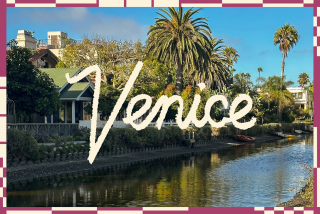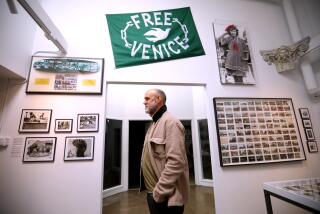Ah, a Venice Boat Ride at Sunrise
- Share via
It was shortly after 6 in the morning by the 15th-Century clock tower on St. Mark’s Square. Venice was quiet. Four men in blue coveralls sang softly as they hosed and swept the marble slabs of the vast piazza. A nun scurried past the pink-and-ivory facade of the Doge’s Palace, which had been struck by the rising sun and glimmered like a wedding cake lit with candles.
I walked to a booth at the water’s edge and, from a sleepy-eyed clerk, bought a ticket on the Linea Uno--Line One, the commuter boat that slices through Venice on the historic Grand Canal.
The Linea Uno runs between St. Mark’s Square (the Piazza San Marco) and the Piazzale Roma, the place where you leave your car before embarking by boat for the heart of Venice. It is an S-shaped route that is lined with palaces that serve as art museums, consulates and homes of the truly wealthy. Popes have been born along this waterway; intrigue has dwelt here forever.
The canal unwinds like a silken ribbon past tiny shops that sell masks and lace, a bustling produce market, and the general post office with its fleet of mail boats. A sunset ride may be more romantic, but dawn is an eye-opener.
Three Bridges
Only three bridges cross the Grand Canal, which is two miles long, between 100 and 230 feet wide and no more than 18 feet deep. Because there is little pavement along the canal, most of its spectacle can only be seen from the water. And there the wonder is doubled, because of limpid reflections.
I chose a seat outside and near the bow as we headed away from the sun. The ornate palaces of Venice shone on either side, their balconies begging for drama, their tall shutters still closed.
A large red boat cut silently in front of us and pulled up near the Hotel Monaco and Grand Canal. It was the milkman; boys hurried out to unload blue plastic hampers.
While buses and trams stay on one side of the road in ordinary cities, the boats of Venice zigzag from right bank to left in what seems to be a free-for-all of ancient rules known only to intrepid gondoliers and other Venetian seamen. When vessels brush too close and cause a rocky wake, eyes roll and arms fly in vivid body language. But that comes later in the day.
An Earnest Hush
At this hour there was an earnest hush to the canal and its travelers. The landing stations slowly filled with men and women in business suits, many with newspapers and briefcases. Schoolchildren followed. A couple of white-haired tourists boarded.
The Grand Canal has such a bold kink in its snaking path that by San Toma Station the sun we had left behind was dead ahead. A three-story palazzo , the color of fresh cream, rippled on the right; a marble plaque served as poetic reminder that Lord Byron lived there in 1818 and 1819.
Soon the scene was dominated by the fabled Rialto Bridge, that humpbacked stone arch designed by a man named Da Ponte, who beat out Michelangelo and Palladio for the job. We skimmed past a gondola parking area where 40 of those sleek, long boats were tied to striped poles called palli.
The true wooden gondolas, of which there are only about 300 left, are 36 feet long, 5 feet wide and painstakingly hewn by hand. They are works of grace, with their shining bow teeth and cut velvet cushions and oarlocks that bend at the elbow.
Beyond the Rialto we skirted the flamboyant Gothic palace called Ca d’Oro, which was built in the 1400s and used to be covered with gold, and then the Palazzo Vendramin Calergi, a breathtaking Renaissance masterpiece where Richard Wagner died a century ago.
I found it harder to focus on the past as the pace of the present picked up. A waiter in a long apron strode from the geranium-red Marconi e Milano Hotel and began whipping cloths over cafe tables along the embankment. The tangy smells of wet greens wafted from the vegetable market, where boats were heaped with watercress and leeks.
A barge glided by with cases of Diet Coke and Evian. Another delivery boat was piled with yellow sacks of dog food. On that Monday morning, garbage barges were stopping at the stub ends of narrow lanes to collect bags of trash. A police boat idled nearby.
A Load of Furniture
One boat seemed to be a moving van: It was loaded with a grand piano, two mattresses and an inlaid wooden chest of drawers, its curved legs sticking into the air.
We crossed under my favorite bridge, the plaited wooden span called Accademia near the rich galleries of the Academy of Fine Arts, where Titian and Bellini are household words. There are serene walks here, amid the hidden parks and churchyards.
When I disembarked from the Linea Uno it was 8 a.m., according to the clock tower of St. Mark’s Square. Tourists and pigeons were beginning to squabble. Venice was awake.
And, after a cup of espresso, even I would be stirring.
More to Read
Sign up for The Wild
We’ll help you find the best places to hike, bike and run, as well as the perfect silent spots for meditation and yoga.
You may occasionally receive promotional content from the Los Angeles Times.






